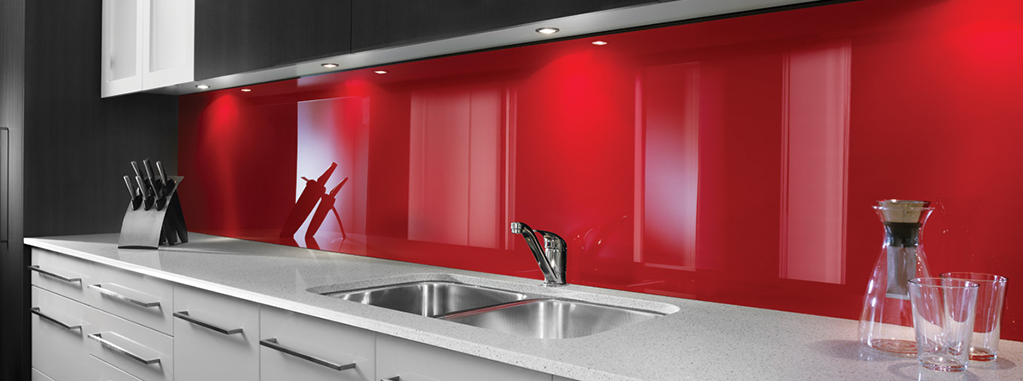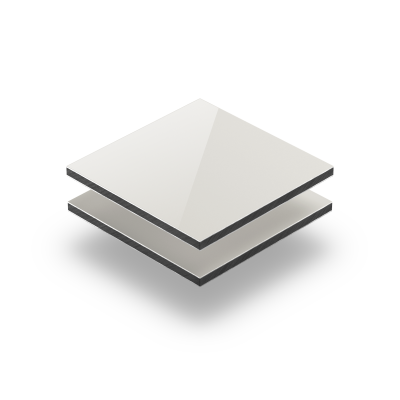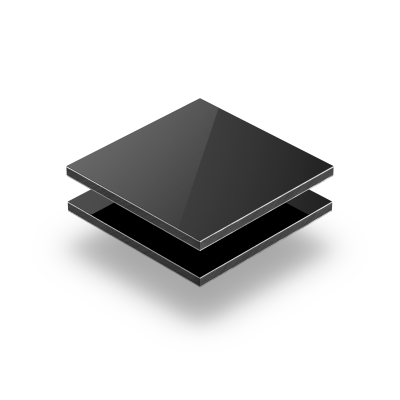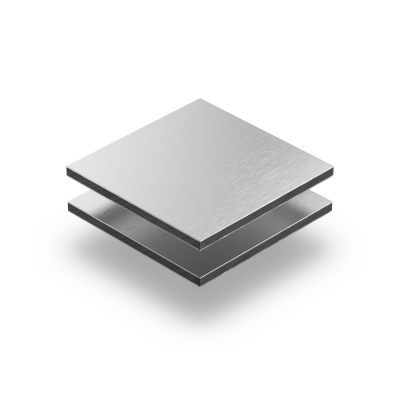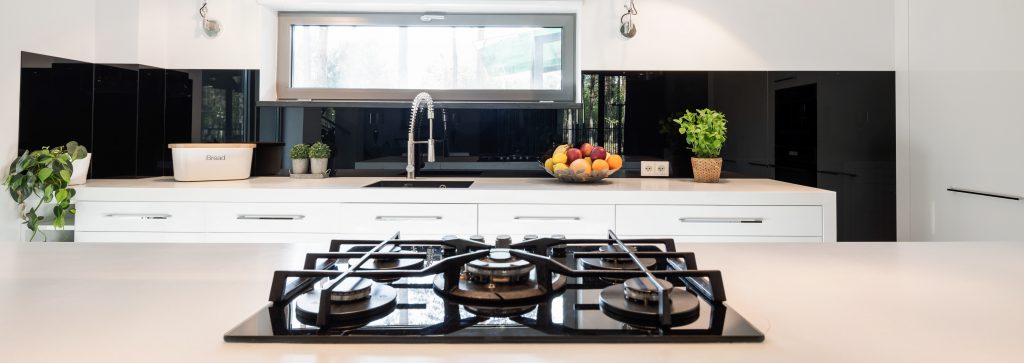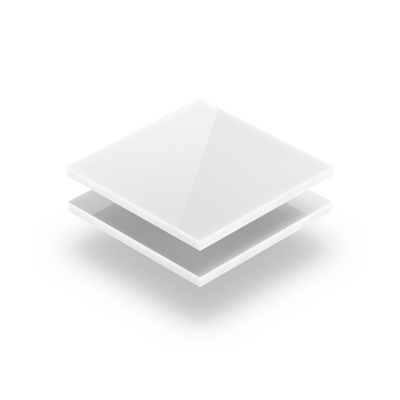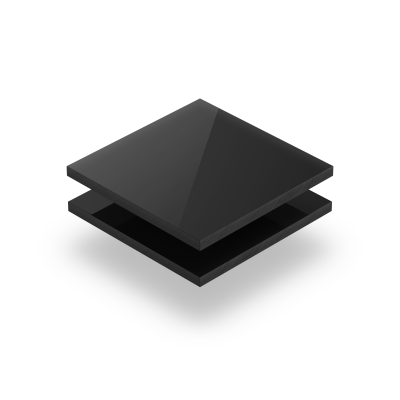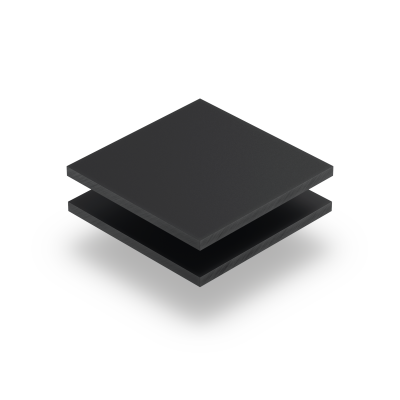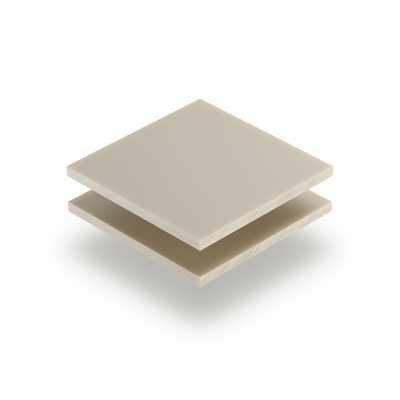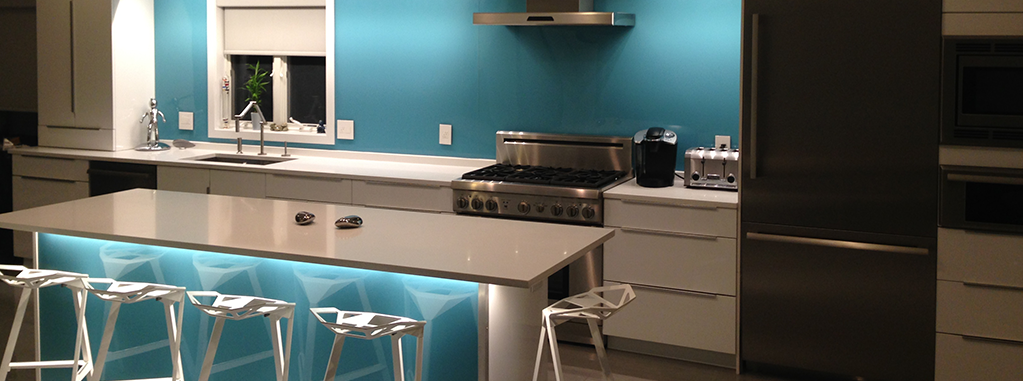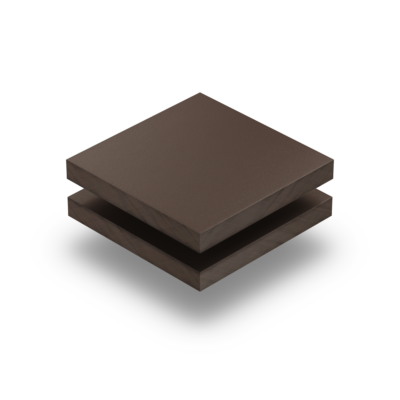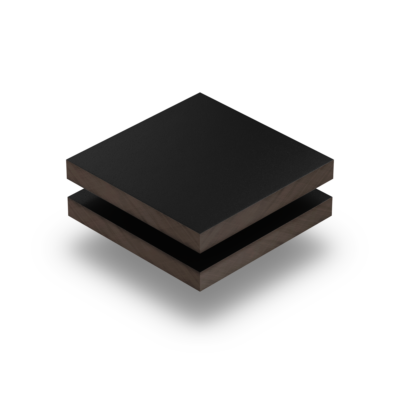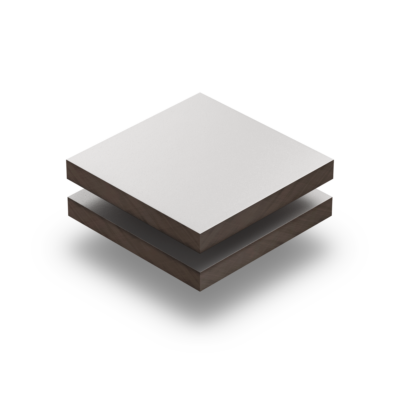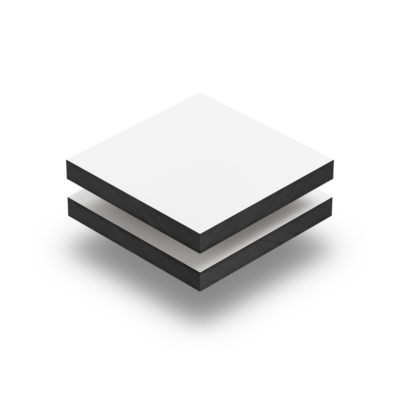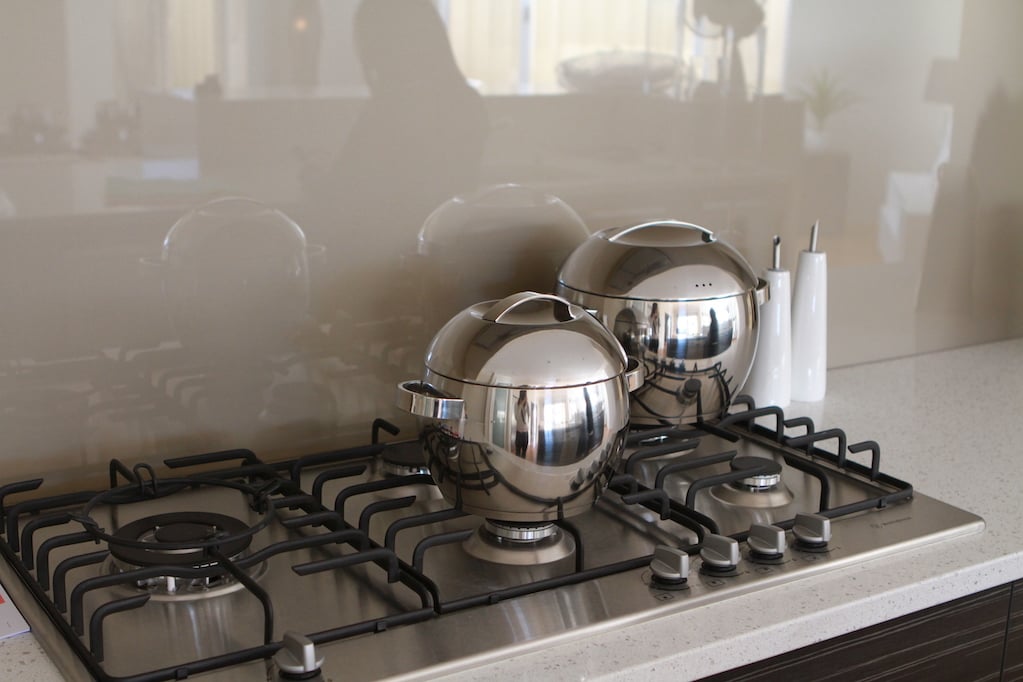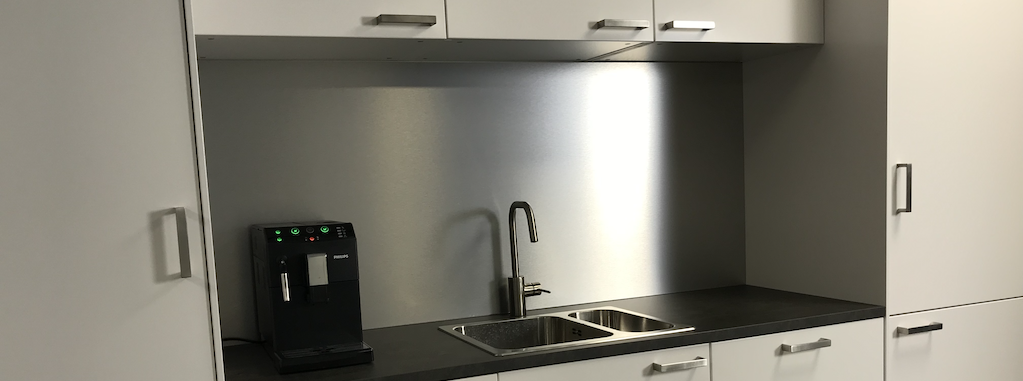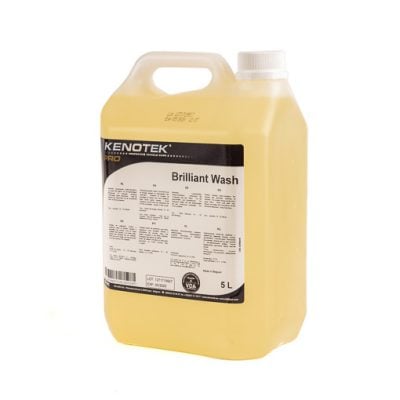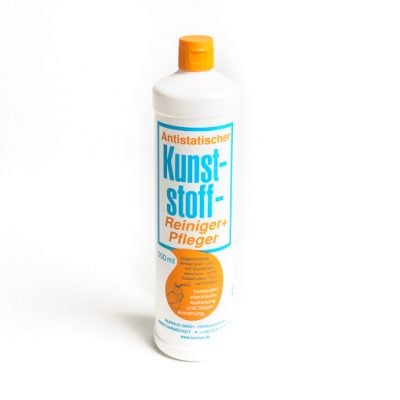Have you installed a beautiful kitchen but still haven’t decided on a worktop splashback? A plastic splashback is an ideal way to protect your kitchen wall from splashes and grease marks and looks very attractive. HPL, acrylic sheet and aluminium panel / Dibond® are all easy to clean, hardwearing and come in a wide range of colours. In this blog, we discuss the most suitable materials and their advantages.
1. What is a kitchen splashback?
Kitchen splashbacks are coverings for the area of wall between your worktop and kitchen cabinets. As the name suggests, they stop splashes of grease and grime from spoiling your kitchen walls and are made of material that is easy to clean. Many people choose to place a loose or fixed splashback on the wall behind their oven or hob. But installing kitchen splashback wall panels on other walls or behind the sink is an excellent idea. It makes cleaning up splashes and other dirt so quick and easy.
2. A kitchen splashback made of Alupanel / Dibond®
Alupanel / Dibond® or Alusplash is very suitable for a kitchen splashback. It’s easy to clean and very hardwearing. The panels are available in a wide range of colours. Brushed aluminium is right on trend for a kitchen splashback. Brushed aluminium Alupanel looks similar to stainless steel, but it’s less costly and is also stronger. This is because Alupanel / Dibond® consists of three layers: the outer layers are aluminium, and the core is black polyethylene. A winning combination: the aluminium is robust and the plastic core light in weight.
Advantages of an Alupanel / Dibond® kitchen splashback:
- Available cut to size
- A wide choice of colours and finishes
- Easy to assemble
- Hardwearing material
- Inexpensive
- Easy to work with
- Light in weight
Disadvantages of an Alupanel / Dibond® kitchen splashback:
- Greasy finger marks will be visible, especially on brushed aluminium panels.
A typical price for a plastic splashback in matte white Alupanel / Dibond®:
A kitchen splashback with dimensions 200 cm x 60 cm costs £54.49, including shipping and VAT.
3. Acrylic kitchen splashback
Acrylic sheet is another very suitable material for a worktop splashback. The smooth, glossy surface of an acrylic panel gives a high-quality look to any kitchen and is easy to clean. Whether you want a matte black kitchen splashback or a bright colour, acrylic offers endless options. Another advantage of using acrylic is that you can opt for a transparent splashback made of clear acrylic sheet. This option allows you to get creative with your kitchen design. For example, an old masonry feature wall in the kitchen can still be seen, but now, you’ll never have to clean it again. You can use opal colours to conceal any unattractive aspects behind the acrylic. Alternating transparent and opal panels create an exciting effect. For a truly stunning look, take advantage of acrylic’s light-conducting properties. When you mount LED lighting on the front, the whole panel will light up, giving your kitchen a contemporary, high-tech look. Tip: place the LED strips at the top so that the strips don’t bear the panel’s weight. You can conceal the LEDs behind a frame if you prefer.
Advantages of an acrylic kitchen splashback:
- Available cut to size
- Comes in a wide range of colours
- Easy to assemble
- Robust material
- Affordable
- Lightweight
- Easy to work with
Disadvantages of an acrylic splashback:
- Must not be used behind a gas stove
- Less resistant to scratches than HPL or Alupanel
A typical cost of a transparent cast acrylic kitchen splashback:
A kitchen splashback with dimensions 200 cm x 60 cm cost £51.14, including shipping and VAT.
4. HPL / Trespa® as a kitchen splashback
If you want a very scratch resistant kitchen or sink splashback, HPL / Trespa® is the best option. This panel consists of resin-compressed wood fibres and has a very strong top layer. The panel is as strong as hardwood, and you can’t bend it. As well as scratch resistance, HPL is unaffected by moisture, mould or wood rot; this is why HPL panels stay beautiful for as long as 30 years. Another significant advantage is that dirt does not adhere to them readily.
Advantages of an HPL / Trespa® kitchen splashback:
- Available cut to size
- Comes in a wide range of colours
- Inexpensive
- Easy to assemble
- Hardwearing material
- Scratch-resistant
- Easy to keep clean
Disadvantages of an HPL / Trespa® kitchen splashback:
- Heavier
- More difficult to work with than acrylic sheet or Alupanel
The typical cost of HPL kitchen splashback wall panels:
A kitchen splashback with dimensions of 200 cm x 60 cm wide costs £54.16, including shipping and VAT.
5. Splashback for hob and gas stove
One frequently asked question is concerning the heat resistance of a plastic splashback. This is only important if you have a gas stove. Prolonged and extreme heat may cause your kitchen splashback’s plastic core to melt or deform, so it’s essential to avoid direct contact between the flame and the splashback. We recommend that if you have a gas stove, you should install your splashback at least 10 cm away from the back gas burner. Not possible for you? Protect the splashback behind the stove with a heat resistant panel.
Anyone who cooks on induction or a ceramic hob has nothing to worry about. But it’s essential to be careful with hot pans. Ensure that they don’t come into direct contact with your plastic splashback (so be especially careful with large pans). If this might be a problem, it’s best to protect the wall behind your hob with a heat resistant splashback.
6. Fitting a kitchen splashback
It’s easy to attach an opaque kitchen splashback to an existing tiled wall with sealant adhesive. The surface must be perfectly flat. It’s best to mount opal-coloured and transparent panels with a glue edge or U-profile. Before fixing, the panels must be cleaned and prepared thoroughly. First, treat the back: remove the protective foil and apply a cleaning and protection agent. We recommend Burnus anti-static cleaner for this job. Do the front only after mounting. If you’re mounting different panel parts, work out in advance the degree of expansion of the material you are using. Then you’ll know how many mm you must leave between the panels. Use tape to hold the top of the panel against the wall. At the base, support it with filler pins.
When the panel is positioned correctly, you can start glueing. Choose a sealant that adheres well to both the sheet material you are using and the substrate. When the sealant edge has dried, remove the fillers and tape. Now all you have to do is to fill those spots with sealant. Lastly, remove the front protective film and treat the panel with an anti-static cleaner.
7. How to keep your splashback looking good
Plastic splashbacks are best cleaned with mild soapy water and a microfibre cloth. To stop your back wall from attracting dust, clean it regularly with an anti-static cleaner, such as Burnus. This is particularly relevant if you have an Alupanel or acrylic kitchen splashback.
8. Ordering a kitchen splashback made to measure
Would you like a beautiful kitchen splashback for your kitchen that won’t break your budget? Order your kitchen splashback panel via our webshop, and we will cut it to size for you in any shape you choose. Do you have your own design, and would you like us to mill the holes for your sockets, for example? Just upload your design via a DXF file. If you have a question about this blog or one of our products, please don’t hesitate to contact us.
Pin this blog on Pinterest
Pin this blog so you can always refer to it when you want to get started? Then pin one of these pictures to your Pinterest.

